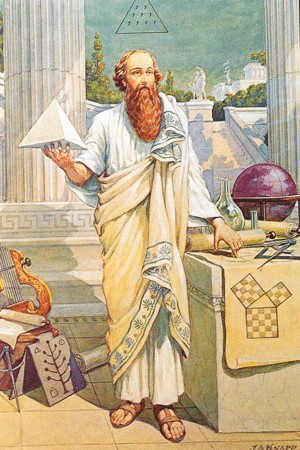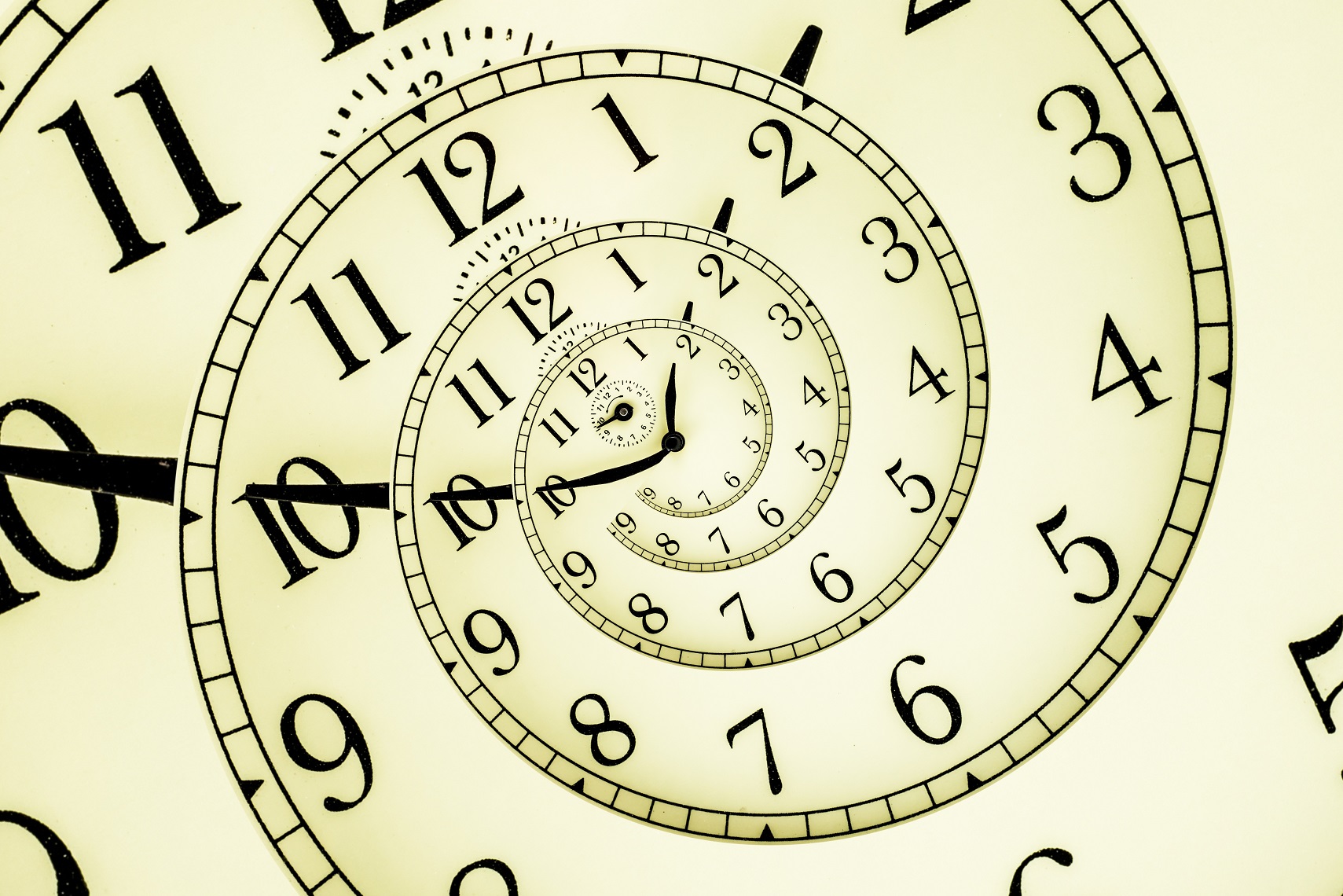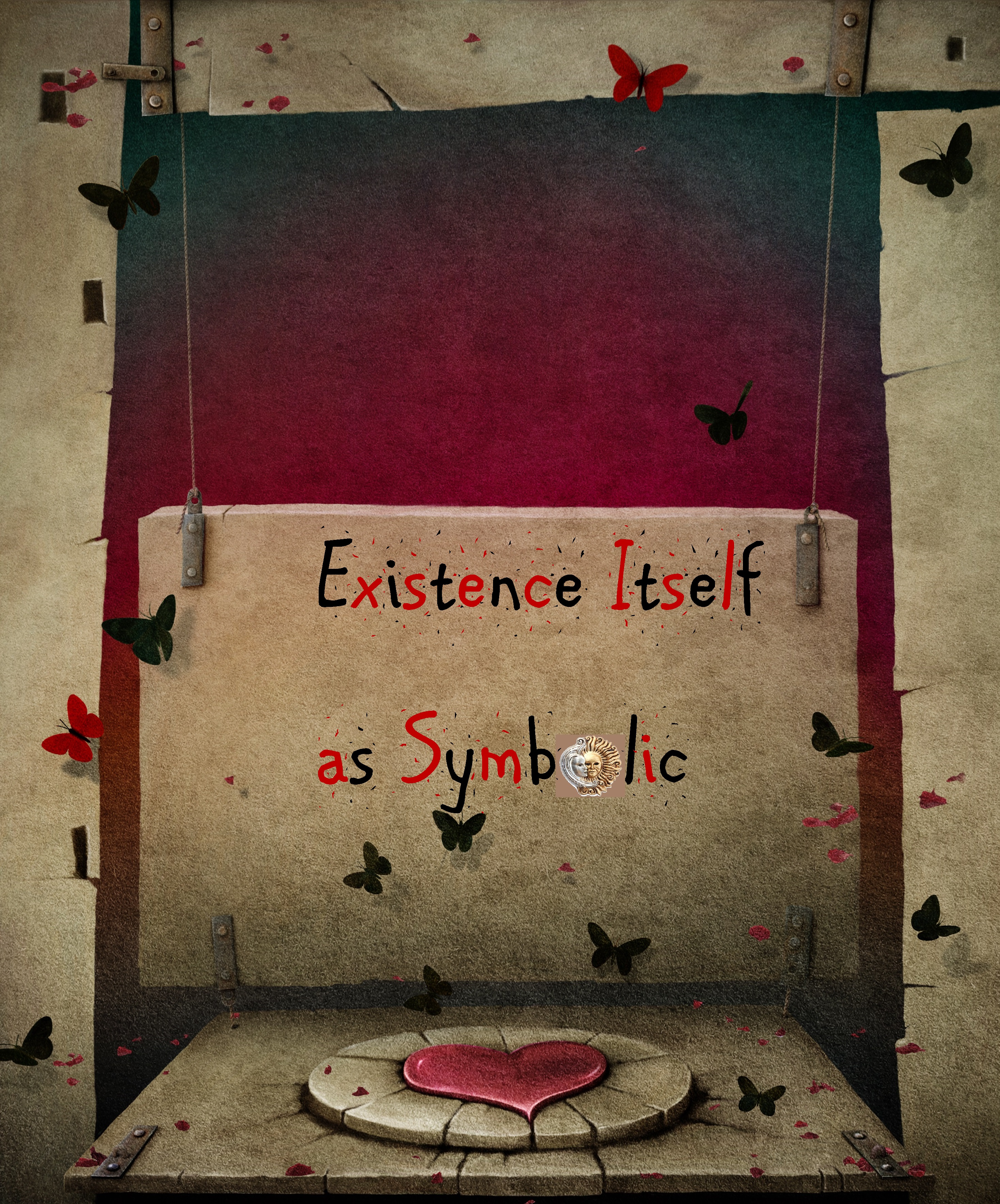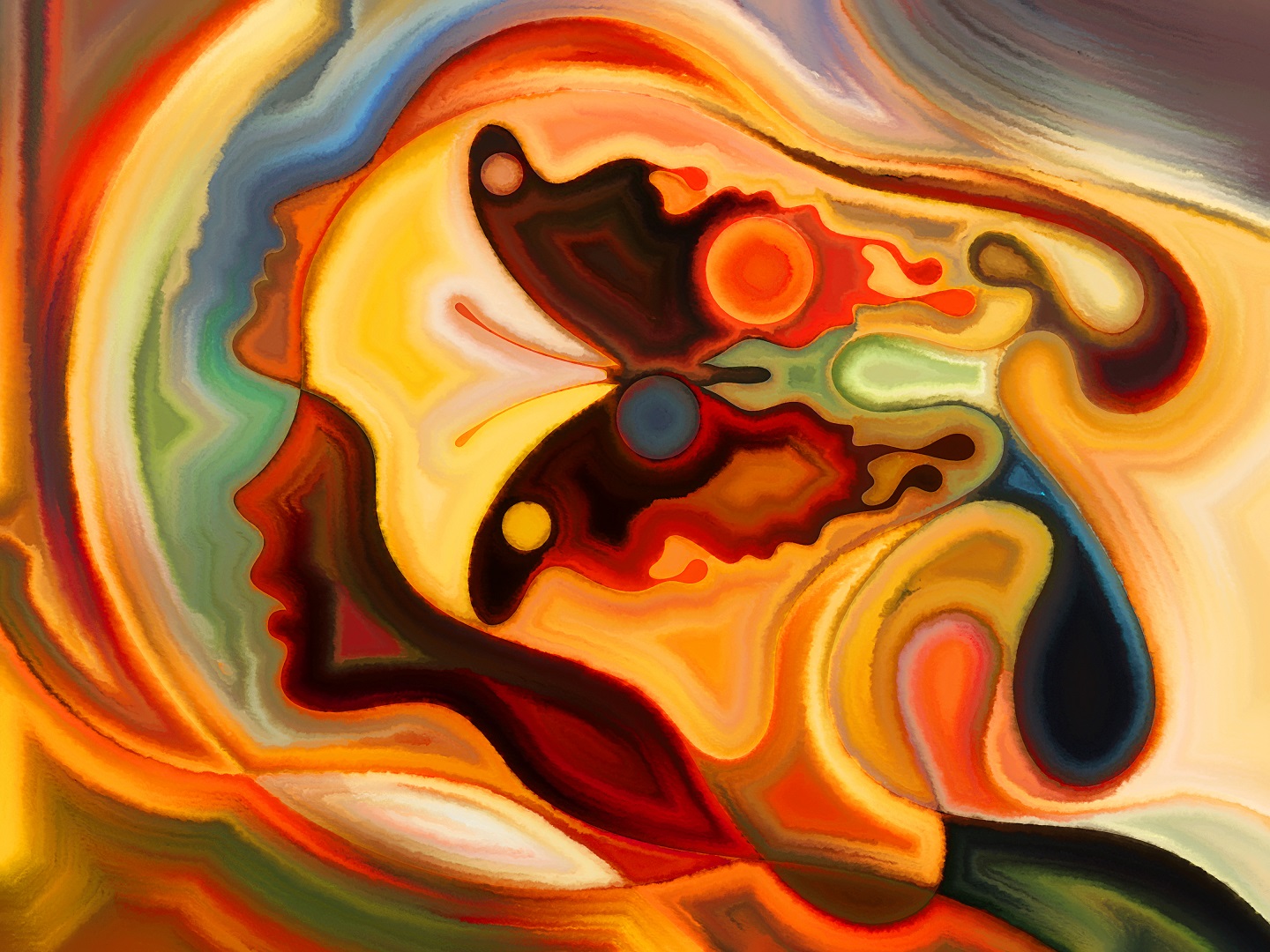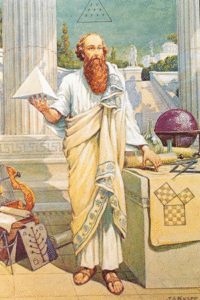
For years, Pythagoras would have mulled over mathematical formulae and other secrets entrusted to him by the Egyptian priests, the Persian Magi and the shamans of Hindustan before stumbling onto the numerical formula which underpinned the primary consonances of the diatonic (musical) scale. A delightfully romantic but unlikely legend speaks of a time when Pythagoras was brought to a halt whilst casually strolling by a noisy brazier’s shop because his attentive ears had honed into the harmonies and discords made by the synthesis of four different sized anvils as they beat out a piece of metal. Walking into the shop for a closer examination of the instruments, he was delightfully surprised to discover that they expressed a proportional relationship of 12: 9: 8: 6. He was able to replicate the sounds at home by constructing an elongated piece of wood, fastening four identical, equal-length chords along its vertical trunk and hanging the corresponding weights off them.
Using this contraption, he descried the golden ratios of harmony. When sounded together, the first and second as well as the third and fourth chords yielded the harmony of the diatessaron, with the tension of the former being a fourth greater than that of the latter (4:3 or sesquitertion). Alternatively, the first and third together with the second and fourth chords yielded the harmony of the diapente, with the tension of the former strings being a third greater than the latter two (3:2 or sesquialter). By the same logic, the first and fourth chords yielded the harmony of the octave, with the tension of the former being double that of the latter (2:1 or duple). The fractional harmony within an octave which no doubt represents the numerical value of 1 reveals the laws of the microcosm as bequeathed to Pythagoras by the “sacred science” of the Egyptian priesthood. Further, it appears the numbers in the ratios themselves are the same numbers to be found in Pythagoras’s pyramidal formula, the tetractys, in which ten dots arranged in four lines of 4, 3, 2 and 1 demarcate the numerical secret of all Creation. But why should Pythagoras think that the key to all Creation was encompassed in something as simple as arithmetic, mathematical formulae and ratios?
Simple really. His ingenuity was such that he was able to syncretise what he’d learned about arithmetic, geometry, astrology and mysticism with his own discoveries expressing the mathematical basis of the musical scale into an original and holistic conception of the cosmos that answered all the fundamental questions of existence. His outlook was so ground-breaking that it was to infiltrate the thinking of both Plato and Aristotle and directly influence the central tenets of magical and alchemical esotericism. Through his ruminations on the laws of consonance, dissonance and the musical scale, Pythagoras reasoned that everything in the cosmos was subject to physical laws which increased or decreased in number depending upon the complexity of the matter in question, be it organism, idea, subject and so forth. Thus astronomy was hinged on musical theory, music on geometry and geometry on arithmetic. It mimicked the ecological food chain in that the removal of any one from the ascending or descending order would in effect annihilate the denominations above it. All were inexplicably linked and co-dependent upon one another, save for arithmetic which was rudimentary to all knowledge and could stand alone.
By this logic Pythagoras ascertained that the secret of Creation must be numerical in nature. It was an art of multiplication which proceeded in harmonic proportions in the same manner than a snake might proceed in spirals or S-bends; one became four, four became ten, the sacred Pythagorean number, which unravelled to produce the splendour of all things, living or inanimate. Despite its simplicity and unsophistication, there is an undeniable and indelible truth to this cosmological scheme. Take the ordering of electrons in a molecule of water, for instance. When two atoms of hydrogen bind to one of oxygen to form the life-giving substance, the former contributes two electrons as a pair whilst the latter offers up eight. Two and eight make ten, the sacred number of the Pythagoreans. In cellular mitosis the DNA replication preceding the division of a mother cell into two daughter cells follows the aforementioned numerical laws. We see the harmonious ordering repeated in cellular meiosis, a more complex form of cell division relating to sexual reproduction which aims to divide a diploid cell into four daughter haploid cells. Naturally the forces at work in the structure of matter and genetics are some of the most intricate processes known to man, and they too follow the Pythagorean scheme of harmonic proliferation.
Using the tetractys (the ten dots) as a skeletal framework for his ordering of the cosmos, Pythagoras proceeded to divide it up in accordance to what he’d learned and what he perceived to be true. No doubt he would have perceived the universe to be a living organism, entirely conscious, with an invisible monochord which stretched from Absolute Spirit, or Ether at the very top to created Nature at the very bottom and passed through the numerous dimensions that had ruptured from the time origin or first cause.
The upper three dots of the tetractys or what one might imagine to be the capstone top of a pyramid symbolised the Supreme World with its archetypes, signatures and seals. This was the region of supernal white light, the eternal fire, a state of being which was undifferentiated, uncreated, undefiled, true and wholly good. Without it there would have been no cogitation and there would be nothing to become. Below that are two rows, one with three and the other with four dots, respectively. These are the seven creative powers which brought forth the material universe, known to the Jews as Elohim and to the Egyptians as neters. Pythagoras envisioned this area of the tetractys as the irrational sphere or the domains of the Superior (heavenly) and Inferior (earthly) Worlds. Seeing that numbers are related to form, the geometrical equivalent of three and four are the triangle and square, shapes which delineate loss of androgyny and unity, the separation into male (triangle; active) and female (square; passive) which leads to the experience of duality and the seven-fold division of the entire cosmos after the first cogitation. Angels, daemons, demi-gods, mortals and all created matter–the stars, the planetary spheres, the four elements of fire, air, earth and water which combined in unique ways to create the lower kingdoms–were all confined to this plane. According to Pythagoras, each planet issued a unique noise as it displaced the heavenly ether, an occult phenomenon he later branded “Music of the Spheres” and claimed he could hear. He used his occult knowledge of homologies and analogies to assign colours, names, emotions, character traits, geometrical shapes, numbers, harmonic intervals and musical notes to each of the seven dimensions that emanated from the first cause. Further, he intimated that everything had been created possessed an inverted blueprint or signature linking it with its divine prototype in the Supreme World.
Some sources claim that Pythagoras possessed a wheel of some sort which he used to divinise and reveal to those initiated into his school their past incarnations. Metempsychosis or soul transmigration was more or less a popular ideology due to the hierarchical division of a society in which most would have been confined to the lower class. It would have verified the truth of divine justice in the minds of those who were forced to endure congenital misfortunes such as physical and intellectual handicaps or slavery. One may have been born into misery but if he or she pursued the righteous and honourable path the rewards would come when the invisible mooring post turned the cosmic wheel onto the next life. It was a belief that appeared to suite the eschatological needs of the people at that point in time and Pythagoras generated favourable conditions for its reception by claiming to remember his own precious incarnations, four in all. I guess we can never know whether the claims were a genuine conviction or just the scheming machination of a swindler, though what’s certain is that it equipped him with a magnetism that was to have an extremely powerful effect on the socio-political climate of Crotona.
Ironically, it was the same magnetism which hastened his descent towards an untimely and unjust death. According to Edouard Schure, a rejected candidate by the name of Cyton became so disillusioned with Pythagoras that he declared war upon him. Many Pythagoreans perished during this uprising. The great teacher sought refuge in a cottage on the outskirts of Crotona with some of his followers, but Cyton managed to track them down and set it alight. Poisonous fumes from the growing fire asphyxiated everyone inside, including Pythagoras. No doubt it was an end tainted with violence and heartache, but I couldn’t think of a more perfect one for a life that was amorous, fiery and restless, mirroring chemical neurotransmission because it had been so full of action potential…
I would like to conclude this post to a poem I have written in honour of Pythagoras (published in my 2008 literary collection Hermetica: Myths, Legends, Poems).
Pythagoras’ Theorem
Music, vowels and colours form monochords
in the mind of every true magician,
composite keynotes that if struck
destroy the heart of any love technician.
Using the lyre of seven strings
do they rock me steadfast to sleep,
each individual harmony reawakening
a heartache of memories buried deep.
Dressed in white light the drizzle distills
the harmonic intervals of red, yellow and blue,
listening for your symphony, Mnemosyne,
to ordain if our love be true.
Before first light, under your purpled note,
the seventh, am I mercilessly torn,
but when your morning stars sing together
as the sharpest am I again reborn.
Musical medicine, forming the start and
endnote of every artistic mind,
unable to touch the lives of those
to whom Pythagoras has been unkind.

